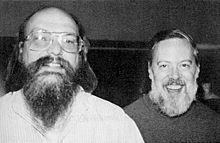What is C?
The C programming language was developed at Bell Labs by Dennis Ritchie (1941-2011, right in picture below) for the development of Unix. As the story goes, C came after A and B — two discarded languages. The third attempt named after the third letter of the English alphabet (C) was the winner. It takes system programmers to make a decision based only on the order of letters in the alphabet.

C is the heart of Unix and all its derivatives. This means that to really know Unix, BSD, Linux and related OSs, you need to know C.
Since many OSs are written in C partially or completely, you can use C to program in most OSs and even manipulate the OS if needed even calling code written in assembly. C allows you to work closely with the hardware regardless of the OS. In other words, C is cross-platform, in part thanks to the POSIX (Portable Operating System Interface) standard that software vendors must follow in order to sell products and services to the US government.
Abstract: ISO/IEC 9945-1: 1990 (IEEE Std 1003.1-1990), Information technology—Portable Operating System Interface (POSIX)—Part 1: System Application Program Interface (API) [C Language] is part of the POSIX series of standards for applications and user interfaces to open systems. It defines the applications interface to basic system services for input/output, file system access, and process management. It also defines a format for data interchange. This standard is stated in terms of its C binding.
https://www.govinfo.gov/content/pkg/GOVPUB-C13-bf1fc57a5dbcaa993cebad99aca83f64/pdf/GOVPUB-C13-bf1fc57a5dbcaa993cebad99aca83f64.pdf
From the various programming languages I have studied and/or worked with, C remains the most intuitive to my thought process after BASIC where a simple command like printf("Hello, World!") can return a simple output ("Hello, World!") while closely interacting with the OS (stdout, standard out).
